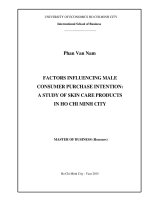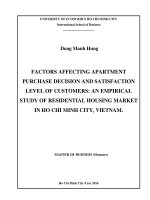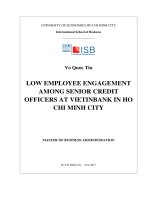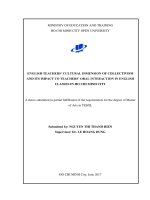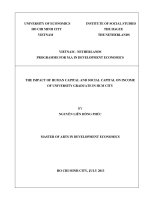common errors in reported speech made by 11th graders at an upper secondary school in ho chi minh city
Bạn đang xem bản rút gọn của tài liệu. Xem và tải ngay bản đầy đủ của tài liệu tại đây (713.49 KB, 145 trang )
VIETNAM ACADEMY OF SOCIAL SCIENCES
GRADUATE OF ACADEMY OF SOCIAL SCIENCES
Nguyễn Lê Văn
COMMON ERRORS IN REPORTED SPEECH
MADE BY 11
TH
GRADERS AT AN UPPER
SECONDARY SCHOOL IN HO CHI MINH CITY
MA THESIS IN ENGLISH LANGUAGE
HO CHI MINH CITY, 2020
VIETNAM ACADEMY OF SOCIAL SCIENCES
GRADUATE OF ACADEMY OF SOCIAL SCIENCES
Nguyễn Lê Văn
COMMON ERRORS IN REPORTED SPEECH
MADE BY 11
TH
GRADERS AT AN UPPER
SECONDARY SCHOOL IN HO CHI MINH CITY
Field: English Language
Code: 8.22.02.01
Supervisor: Lê Hương Hoa, Ph.D.
HO CHI MINH CITY, 2020
DECLARATION BY AUTHOR
I declare that this thesis “Common Errors in Reported Speech Made by 11th
Graders at an Upper Secondary School in Ho Chi Minh City” is carried out by
my own and I am the sole author of this thesis. To the best of my knowledge of
Reported speech grammar, I use some other author’s works to give two minitests for my study, and this thesis is submitted after a carefully checking progress
in order to fulfill the requirements of the M.A degree.
Author’s signature
Nguyễn Lê Văn
Approved by
SUPERVISOR
Lê Hương Hoa, Ph.D.
Date: ………………
i
ACKNOWLEDGEMENTS
This thesis is completed with lots of working hours and is contributed by a
large amount of enthusiasm, effort and assistance from many people. Firstly, I
would like to express my sincere gratitude to my advisor, Dr. Lê Hương Hoa for
the all support of my research, for her patience, motivation, and immense
knowledge. Her guidance helped me in all the time of doing research and
writing this thesis. I also would like to send my special thanks to Dr. Đặng
Nguyên Giang, who gave me important help with some ideals and documents.
Additionally, I am so grateful for Mai Lan Hương, who wrote wonderful books
which are loved by millions of teachers and students in Vietnam. Her works are
filled by deep feelings in the different ups and downs motions, especially during
the process of my research. It is the source of inspirations for me to fulfil this
task. Finally, I want to be grateful to my family for all, who are always
supportive and enthusiastic during the progress of writing this thesis.
Thanks to all.
ii
TABLE OF CONTENTS
Page
DECLARATION BY AUTHOR...................................................................................................... i
ACKNOWLEDGEMENTS............................................................................................................... ii
ABSTRACT............................................................................................................................................. vi
LIST OF TABLES............................................................................................................................. viii
LIST OF ABBREVIATIONS AND SYMBOLS USED IN THE THESIS............ix
CHAPTER 1: INTRODUCTION.............................................................................................. 1
1.1. Rationale............................................................................................................................................. 1
1.2. Aims of the Study........................................................................................................................... 2
1.3. Scope of the Study......................................................................................................................... 2
1.4. Significance of the Study........................................................................................................... 3
1.5. Research Questions....................................................................................................................... 3
1.6. Research Methods.......................................................................................................................... 4
1.7. Structure of the Study.................................................................................................................. 4
CHAPTER 2: LITERATURE REVIEW.............................................................................. 6
2.1. Previous studies related to reported speech...................................................................... 6
2.2. Errors.................................................................................................................................................... 8
2.2.1. Classification of errors............................................................................................................ 8
2.2.2. Sources of errors...................................................................................................................... 10
2.2.3. Error analysis............................................................................................................................. 15
2.3. Reported speech........................................................................................................................... 16
2.3.1. Definitions................................................................................................................................... 16
2.3.2. Types of reported speech..................................................................................................... 17
iii
2.3.3. Changes of direct speech when turning into reported speech..........................21
2.3.4. Summary of reported speech used in the textbook “Tiếng Anh 11”.............31
2.4. Chapter summary........................................................................................................................ 34
CHAPTER 3: RESEARCH METHODOLOGY........................................................... 35
3.1. Research setting........................................................................................................................... 35
3.1.1. An overview of Nguyễn Hiền Upper Secondary School.................................... 35
3.1.2. The teachers’ background and their teaching conditions.................................... 35
3.1.3. The students’ background................................................................................................... 36
3.2. Methodology.................................................................................................................................. 38
3.2.1. Research questions................................................................................................................. 38
3.2.2. Subjects of the study.............................................................................................................. 38
3.2.3. Data collection instruments................................................................................................ 40
3.2.4. Data collection procedures................................................................................................. 45
3.2.5. Data analysis.............................................................................................................................. 45
3.3. Chapter summary........................................................................................................................ 45
CHAPTER 4: FINDINGS AND DISCUSSIONS........................................................... 46
4.1. Results and analysis from questionnaires....................................................................... 46
4.2. Results and analysis from two written mini-tests....................................................... 55
4.2.1. Results and analysis from the first test......................................................................... 55
4.2.2. Results and analysis from the second test.................................................................. 56
4.2.3. Results and analysis from two written mini-tests................................................... 58
4.3. Chapter summary........................................................................................................................ 84
CHAPTER 5: CONCLUSION.................................................................................................. 86
5.1. Recapitulation................................................................................................................................ 86
iv
5.2. Concluding Remarks................................................................................................................. 88
5.3. Pedagogical Implications........................................................................................................ 89
5.4. Limitations and Suggestions for Further studies........................................................ 92
REFERENCES................................................................................................................................... 93
APPENDIX 1: TEST 1......................................................................................................................... I
APPENDIX 2: TEST 2..................................................................................................................... IV
APPENDIX 3: QUESTIONNAIRES...................................................................................... VII
APPENDIX 4: INTERVIEW....................................................................................................... XII
APPENDIX 5: WEBSITES OF REPORTED SPEECH.............................................. XIII
APPENDIX 6: PERCENTAGE CHARTS FROM QUESTIONAIRES.............XIV
APPENDIX 7: RESULT TABLES OF TWO WRITTEN MINI-TESTS............XX
v
ABSTRACT
English grammar is regarded as the most important factor to students’
learning English, in which reported speech grammar is one of the biggest points
that is often used in tests and exams at schools, especially in entrance
examinations. However, 11 graders’ ability still have many limitations and need
much more instruction from their teachers at an upper secondary school. The
findings of the study are concerned with recognizing common errors that
students usually make when changing indirect speech statements into reported
speech ones, and providing some solutions in order to help them avoid making
errors in performing this kind of grammar point. Besides, the research also helps
teachers give useful pedagogical implications in improving the quality of
lectures included in the textbook “Tiếng Anh 11” as well as lessons on reported
speech grammar. In addition, teachers can apply some suggested exercises in
this study for their lessons.
In this research, the researcher used two instruments, including the
questionnaire and two written mini-tests for students. The subjects involved in
this study were 23 students of a class including 14 school-girls and 9 schoolboys who are 11 graders at an upper secondary school in Hồ Chí Minh City.
They were invited to participate in the survey questionnaire as well as doing two
written mini-tests. Besides, some English teachers in the school also took part in
to give best advices in an interview for learning reported speech. During giving
the instruments, there were 23 participants handed in the questionnaire and the
vi
mini-tests to the researcher in total, and five teachers teaching English for 11
graders finished the questions in the interview.
Hopefully, the findings of the research will help both teacher in giving
effective teaching lessons and students in learning and mastering reported
speech grammar point.
vii
LIST OF TABLES
Page
Table 9: Groups of students depending on their performing levels in English
subject................................................................................................................................................. 69
Table 15: Comparison between 5 groups through two written mini-tests...............77
Table 18: The order of ascending difficulty of changes................................................... 84
viii
LIST OF ABBREVIATIONS AND SYMBOLS USED IN THE THESIS
HCM.C : Hồ Chí Minh City
%
: Percentage
ix
CHAPTER 1: INTRODUCTION
1.1. Rationale
These days, English is the language widely used in the world. English is not
only the national or official language of some countries which have different
cultures, but it is also the international language of communication in many
fields including science, technology, business, entertainment and so on. Since
when Viet Nam joined in international commercial organizations such as World
Trade Organization (WTO), Asia Pacific Economic Co-operation (APEC) and
Asia Europe Meeting (ASEM), the need for learning English has been
considerably increasing among Vietnamese due to their proficiency in English
which can help them get good jobs. Therefore, learning English is very
necessary.
It, however, is not easy to master this language. In order to become good
English learners, besides proficiency in speaking, listening, reading and writing
skills, they must use grammar properly. Numerous studies show that the use of
poor grammar in spoken and written statements negatively reflects on the
speakers or authors, and those people, who use imperfect grammar, are instantly
perceived as being less intelligent, reliable or trustworthy than people who use
proper grammar.
Consequently, it is essential for English learners to master grammar. Among
the grammar points, reported speech is important but rather difficult now that it
involves a lot of elements which causes students to feel confused and make a
range of certain errors. Making so many errors of reported speech is not good
because when someone reports incorrectly what others have said, it is difficult
1
for listeners to understand or it is even easy for them to misunderstand, causing
serious consequences. In addition, reported speech often appears on common
tests, final tests in classes and especially tests in the entrance exams to
universities and colleges.
Therefore, if students do not master this grammar point, they may lose marks
relating to reported speech easily. For those above certain reasons, the researcher
decided to study the topic “Common Errors in Reported Speech
th
Made by 11 Graders at an Upper Secondary School in Ho Chi Minh City”.
1.2. Aims of the Study
The overall aim of the study is to help 11 th graders at Nguyễn Hiền Upper
Secondary School avoid making errors in preforming reported speech grammar.
With that aim achieved, the researcher will suggest appropriate teaching
methods that meet students’ needs with the hope to enhance their ability of
learning reported speech grammar point as well as quality of learning English
grammar. To achieve the above aim, the following objectives are set for
exploration:
(1) To find out 11 graders’ common errors in using reported speech.
(2) To suggest some solutions to help the students avoid these errors.
(3) To improve the quality of teaching and learning English at the school.
1.3. Scope of the Study
The study is about common errors of reported speech based on the exercises
given by the researcher to 23 students who are 11 th graders at Nguyễn Hiền
Upper Secondary School.
2
1.4. Significance of the Study
The findings of the study are focus on not only recognizing common errors
that students usually make when changing indirect speech statements into
reported speech, but also providing some solutions in order to help them avoid
making errors in performing this kind of grammar point. Furthermore, the
research also helps teachers give useful pedagogical implications in improving
the quality of lectures included in the textbook “Tiếng Anh 11” as well as
lessons on reported speech grammar. In addition, teachers can apply some
suggested exercises in this study for their lessons.
Hence, the findings of the research will help get deeper insights into
students’ learning reported speech grammar towards the aforementioned
solutions, which in turn stimulate the adjustment on the part of teachers to
accord with students’ needs and wants. The suggestion of appropriate solutions
made by the writer of this paper will significantly contribute to reported speech
grammar teaching and learning outcomes. In short, valuable information from
the questionnaires and the two written mini-tests will help shorten the gap
between theory and practice at least in this context.
1.5. Research Questions
The research is carried out to answer the three following questions:
(1) What is the students’ attitude towards learning reported speech?
(2) What are common errors that the 11th graders usually make when
dealing with changing direct speech into reported speech?
(3) What are some solutions to these problems?
3
1.6. Research Methods
This study is qualitatively and quantitatively conducted with the descriptive,
analytical, synthetic, and inductive methods. A survey with the questionnaires,
interview and the two written mini-tests are carried out to investigate the
common errors of reported speech made by 11 th graders at Nguyễn Hiền Upper
Secondary School.
1.7. Structure of the Study
At this stage, it should be pointed out that in accordance with the research
problems; the study is divided into five chapters:
Chapter 1: “Introduction” presents the reasons for choosing the study, the
aims, the research methods, and the scope of the study along with its design.
Chapter 2: “Literature review” reveals the relevant literatures on reported
speech grammar carried out by both foreign and Vietnamese researchers in the
past. Besides, it also gives specific introduction about errors and research’s
aspects on reported speech grammar such as definition of reported speech, types
of reported speech, changes of direct speech when turned into reported speech
and especially summary of reported speech used in the textbook “Tiếng Anh
11”.
Chapter 3: “Research Methodology” presents and describes the research
methodology that was used to carry out the study. Moreover, it presents the
population of the study, the research design, and the procedures that were used
for gathering and analyzing the available data.
Chapter 4: “Findings and Discussions” analyses the data gathered to answer
the research questions.
4
Chapter 5: “Conclusion” summarizes the findings of the study while trying
to address its limitations, and proposes specific initiatives to improve the quality
of teaching, and open the door for further research.
5
CHAPTER 2: LITERATURE REVIEW
This chapter, Literature Review, will present previous studies related to types
of errors of indirect speech made in the context of foreign language teaching.
The literature review will initially look at the terms concerned in the study. The
pertinent literature will be reviewed and analyzed with the intention of providing
a theoretical foundation to the current study.
2.1. Previous studies related to reported speech
In the past time, many studies relating to reported speech have been carried
out. For instances, the study “Teaching Reported Speech” done by Dan Raj
Regmi was about the major mistakes made by the learners of Grade XII of
Management stream in December, 2009. However, the researcher only gave
suggestions for teachers to make clear how they teach their Nepalese students in
order to help them understand and use reported speech precisely. Besides, Dr.
Riskhi Anita Tirta Utama from Muhammadiyah University of Surakarta carried
out a research on “An Error Analysis of Indirect Speech Made by the Second
Year Students of Sma Negeri 1 Wonogiri 2007/2008 Academic Year” in 2008. In
this research, the researcher made clear the types of errors of indirect speech
made by the second year students and found the source of errors of indirect
speech that helps students overcome the difficulties in working with Indirect
speech sentences. Also, this research was given to the second year students and
it just concentrated on copping with types of indirect speech, not specific aspects
of changes in reported speech grammar.
Another study is “Error Analysis of Transforming Direct Speech into
Indirect Speech in Narrative Dialogues at the Second Year Classes of English
6
Department” carried out by Elyza Martiarini and Risa Mufliharsi at University
of Indraprasta PGRI, Jakarta in 2017. Nevertheless, the findings errors of this
research were classified into 4 aspects such as omission, addition, misformation,
and misordering which differ with the classification that the writer uses for study
at Nguyễn Hiền Upper Secondary School.
In Vietnam, Lê Thị Thu Quỳnh, a student of Hồ Chí Minh University of
Pedagogy did the research “Indirect Speech in English and Vietnamese: A
Comparative Contrastive Analysis” in 2010. In this research, the researcher
pointed out basic similarities and differences in indirect speech between
Vietnamese and English as well as some major mistakes made by Vietnamese.
Also, Nguyễn Thị Mỹ Hạnh, a fourth year of English class 2009A of Foreign
Language Faculty at Đồng Tháp University gave a research “Common Errors of
Reported Speech Made by Grade 11 Students at Doc Binh Kieu High School,
Tien Giang Province” in 2013. In this research, the researcher gave result of
usual errors that students made when turning direct into reported speech. The
suggestion was that Vietnamese people have to pay more attention to grammar
structure when they want to change an English indirect speech into the direct
one. However, the researcher gave a general suggestion instead of specific ones
to help learners avoid those errors and the subjects just for learners in Tiền
Giang province, where students, generally, have lower levels at performing
English grammar than those living in Hồ Chí Minh City (HCM.C), the biggest
metropolitan in Vietnam.
Until now, no research has been done on errors in reported speech made by
11th
graders at an upper secondary school in HCM.C. For the purpose of
7
investigating the common errors in reported speech made by 11 th graders, the
researcher has decided to conduct this study.
2.2. Errors
2.2.1. Classification of errors
When a learner develops his second or foreign language system, he makes
errors. In first language learning, these errors are “lapses” or “slips of the
tongue” due to physical or psychological reasons (Brown, 1980). However, in
second language and foreign language learning, these errors are reviewed
carefully. Corder (1973) introduces the distinction between systematic and nonsystematic errors. Non-systematic errors occur in one’s native language, Corder
calls these "mistakes" and states that they are not significant to the process of
language learning. They can be self-corrected when attention is called. He keeps
the term "errors" for the systematic ones, which occur in a second language. He
believes that errors are the evidence of the language system that the learner is
using at a particular point in the course. Corder (1973) refers to three types of
errors. These are: 1) transfer errors; 2) analogical errors and 3) teaching-induced
errors. Chomsky classifies learners’ errors into: 1) performance error and 2)
competence error. Competence is the ‘speaker-hearer’s knowledge of his
language, while performance is the actual use of language in concrete situations.
Heaton (1998) and Littlewood (1984) divide errors into two main types: global
and local errors. Richard (1974) and some other researchers distinguish between
interlingual errors and intralingual errors.
Obviously, errors are classified differently according to perspectives. On the
whole, the most popular classification of written errors that earns scholars'
8
consensus prevailingly is the division of errors into interlingual errors and
intralingual errors. Because, two major factors that contributed to the presence
of errors in students’ written work are interlingual transfer and intralingual
transfer.
The elaboration of these categories is illustrated as below:
i) Interlingual Errors
According to Brown (1980, p.173) the beginning stages of learning a second
language are characterized by a good deal of interlingual transfer from the native
language. Richard (1974, p.35) says that interlingual errors are errors due to
transferring rules from the mother tongue. They are the incorrect elements under
the influence of learners' native language. Therefore, interlingual errors are
errors which are caused by interference from native language to the target
language they learn. Therefore, before someone really master the concept of
their target language they will always use the concept of their native language.
When it happens all the time and they do not realize it, it can be called
interlingual errors.
Obviously, the understanding of intralingual and interlingual error enables
teacher to perceive language teaching form a two-way perspective, which is
different from traditional teaching which only emphasizes target language. This
classification could help the teachers deal with the relationship between
language 1 and language 2 in teaching practice, to trace the origin of errors, and
to decide what language points need more attention.
ii) Intralingual Errors
After learning second language or foreign language for some time, learners’
9
previous experience and their existing subsumes begin to include structures
within the target language itself. According to James (1998, p.183), the less the
learner knows about the target language, the more he is forced to draw upon any
other prior knowledge he possesses. While Brown (1980, p.173) says that it is
clear that intralingual errors or intralingual interference-the negative transfer of
items within the target language, or put another way, the incorrect generalization
of rules within the target language is a major factor in second language learning.
Intralingual errors refer to those out of the influence within the developmental
system of target language, such as faulty generalization, incomplete application
of rules, and so on (Ellis, 1999, p.58).
2.2.2. Sources of errors
We all know that errors are unavoidable in language learning process. These
errors occur because of many reasons. By identifying the sources of error, the
teacher begins to know how learner’s cognitive and affective self relates to the
linguistic system and also to formulate his process of learning a foreign
language.
However, it is by no means easy to identify the actual sources of written
errors in the field of English language Teaching. Different classifications of
errors provide us with different perspectives to analyze the causes of errors.
Brown (1980, p.156) states that errors are caused by the lack of knowledge
about the target language. Edge (1989, p.7) claims that the source of learner’s
errors is the interference from the speaker’s first language. In tone with it,
Richards (1974, p.174) says that the source of errors in studying a language
10
might be derived from the interference of the learners’ mother tongue and the
general characteristics of the rule learning.
In summary, errors can be ascribed to many factors. Some of learners' errors
are due to learners' language competence, some due to cultural interference;
some are results of learners' learning strategies, while others are the products of
communicative strategies. Diverse as these viewpoints are, there should be an
intersection among different schools of thoughts or a clear-cut justification
among them so that these causes are figured out and proper error correction is
offered.
In general, the very causes of written errors can be summed up as below:
i) Interlingual interference
Interlingual interference is the interference of the learner’s first language or
mother tongue onto the process of learning a second language. Mother tongue
interference is one of the major causes leading to learner’s committing errors.
Norrish (1987) states that learning a language (a mother tongue or a foreign
language) is a matter of habit formation. When learner strives to learn a new
habit, the old ones will interfere with the new ones. In other words, the term
"first language interference" best summarizes this phenomenon. Besides, being
able to express fully one's ideas in another language is always a demanding task.
Thus, when learners' second language is not sufficient in expressing themselves,
it is likely that they will rely on their first language to express their ideas. Edge
(1989: 7) is in line with this thought: "when people do not know how to say
something in a foreign language, one possibility is to use words and structures
from their own language and try to make them fit into the foreign language."
11
Moreover, the interference of mother tongue may result from the complication
of the structure of the target language as Abbort et al (1981: 230) argues that
"wherever the structures of the first language and target language differed, there
would be problems in learning and difficulty in performance, and that the greater
the differences were, the greater the difficulties would be."
Undoubtedly, differences and similarities between language 1 and language
2 will affect the learning of the target language greatly. The consideration of the
contrast and comparison between the two languages will for sure contribute to
the analysis of learner' errors. The differences between Vietnamese and English
are manifested in pronunciation, grammatical rules, lexical meaning, and word
order is considered another factor of the interlingual interference as well.
ii) Intralingual Interference
Interferences from the students’ own language is not the only reason for
committing errors. During the process of analyzing the causes of errors, a large
number of errors are found to be the result of intralingual interference within the
target language. As soon as the learner has begun to acquire some parts of the
new language system, more and more intralingual interference will occur. The
errors from intralingual interference normally follow a natural route. As the
learner progresses in the second language, his previous experience and his
existing knowledge begin to permeate for producing new progress, at the same
time arousing new errors. Intralingual interference is the negative transfer of
items within the target language such as the overgeneralization, the wrong
application of rules and results in false conceptualization on the part of the
learner. (Richards 1974:96).
12
According to James (1998), intralingual errors can be divided into 4 items:
a) Overgeneralization
Another possible cause of written errors mentioned is overgeneralization. It
occurs when the learner creates a deviant structure on the basis of other
structures in the target language. It generally involves the creation of one deviant
structure in place of two target language structures. Consequently, students
automatically apply rules wherein they are not allowed to. For examples:
(1) She will cries aloud.
(2) He can speaks English well.
(3) We are hope to see you.
In the examples, the learners overgeneralize that the simple present tense ‘s’
ending is required by the third person singular. Whereas, the form of English
sentences is not fully the same as they expect. In addition, they may reduce their
linguistic burden. To know their mistakes in constructing sentences, the
researcher gives the correct sentences as follows:
(1) She will cry aloud.
(2) He can speak English well.
(3) We hope to see you.
b) Ignorance of rule restriction
This types of errors involves the application of rules to contexts where the
learner does not apply. Here the learner fails to observe the restrictions of
existing structures. For examples:
(1) He asked to me about my family.
13
(2) She told to me her big problem yesterday.
(3) He showed to me his new cars.
In this case, they should reduce ‘to’ in the sentence “He asked to me”
because he applied the same preposition to different verbs. The following
sentences are the correct forms of the sentences above:
(1) He asked me about my family.
(2) She told me her big problem yesterday.
(3) She showed me his new cars
c) Incomplete application of rules
This kind of intralingual error is converse of overgeneralization and
represents the degree of development of the rule required to produce acceptable
sentences. It is typically related to analogy. It involves a failure to fully develop
a structure. Thus learners of language 2 English have been observed to use
declarative word order in questions (for example, “You like to sing?”) in place
of interrogative word order (for example, “Do you like to sing?”). This type of
intralingual error corresponds to what is often referred to as an error of
transitional competence (Richards, 1971).
d) False concepts hypothesized
The last category of intralanguage error that is sometimes called semantic
error is false concepts hypothesized. It derives from incorrect comprehending of
distinction in the target language. These particular errors are the result of poor
gradation of teaching items. The form ‘was’ for example, may be interpreted as
the marker of the past tense, as in “one day it was happened”.
14




